1. Background
Updated March 22, 2008
1.1 What is a 200SX?
That's not as easy a question as you might think. There are at least three cars sold in
different parts of the world under this name. Each is unique to it's market.
The base car for this family is the Nissan Silvia, and it is sold in
Japan and possibly other parts of South-East Asia under this name. Basically, this is a
rear wheel drive two-door "personal sports coupe" powered by a 4 cylinder DOHC engine.
Differences in the models will be covered in another section.
Back to FAQ
1.2 Why "Silvia"?
According to the Chief Designer, Mr. Ootake, the name "Silvia" comes from Greek Mythology
and was the name of a beautiful Nymph. According to Roman Mythology (which borrows from the Greek)
Siliva was the mother of Romulus and Remus (By Mars) and was the daughter of King Numitor. Her uncle
gave her to to the goddess Vesta.
Top of Page Back to FAQ
1.3 History
|
The Early Years
|
CSP311
|
The earliest car I know of to carry the Silvia name was the CSP311 from 1964-68. It was powered by a 1595cc
"R" Engine producing 96HP. Exported to several countries as the Nissan 1600 coupe. Don't confuse this with the 4-door "1600" (510).
According to David Auld, 554 were built, of which 20 still exist in Australia.
|
|
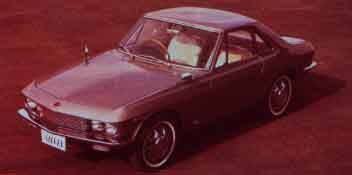
|
|
The "Modern" Silvias
|
S10
|
Introduced 1974.
The original "modern" version. There were limited exports, and in some markets called as "Sakura". Also sold in the USA as a 200SX with an L20B rated at 90HP.
The L20 motor was used in Australia in the 200B (which had an "SX" variant late in it's life), but the 180B and 200B were not Silvias. They were derived from Bluebirds.
|
|

|
S11 & S110
|
Introduced 1979.
Nissan's flirtation with Rotary engines. Only a handful ever produced.
Production continued as the S110 with a conventional piston engine. (designation unknown -
any takers?). According to Alan Marr, the Nissan rotary was a 1000cc twin-rotor design.
With a 4 barrel carburettor, it was similar to the 10A Mazda engine
Like the CSP311, it was exported in limited numbers as the Nissan 1600 Coupe
The S110 had an FJ20E when sold in Japan as a Silvia and a 100HP Z20E (twin plug) when sold in North America as a 200SX, swapping to the 102HP Z22E in 1980.
|
|
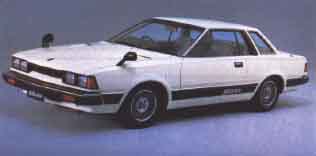
|
S12
|
Introduced 1983.
Two body styles (coupe, hatch). Called a "Gazelle" in some markets and "200SX" in USA. Japanese market cars had FJ20 or FJ20ET 2.0 16V engines, Australian Gazelles had CA20 2.0, 8V "twin plug", while European cars had CA20 or CA18ET engines. USA (not Canada)
got the VG30E in the "200SX SE" (which given it had a 3.0 was interesting). This car had 165HP in 1987, and 170HP in 1988 (identified by two-tone paint).
The Gazelle and North-American 200SX did not have the bulge in the bonnet shown in this photo, as it was restricted to the four cylinder turbo versions.
|
|

|
|
The "Hero Cars"
|
S13
|
Introduced 1988.
Three body styles (coupe, hatch, convertible). Japanese market cars feature
CA18DE and CA18DET engines. USA gets KA24DE (12 Valve in 1989 & 16 Valve
from 1991). HICAS (4-wheel steering) available
as an option on domestic and export cars (restrictions in some trim levels).
In Japan, trim levels were J's, Q's and K's K's are generally turbocharged
although I am told it was possible to order a normally aspirated K's but this
would be unusual.
Export market cars have pop-up lights (which makes them RS or RPS13's), while the domestic cars have fixed rectangular lights.
When the S14 was introduced, the S13 was renamed a PS13 "180SX" (with pop-up lights) and continues to be sold in Japan.Chassis
Numbering on S13's (thanks to Jon for this)
89-91 Silvia: S13 (1.8)
91-93 Silvia PS13 (2.0)
Early 1.8 litre 180SX: RS13
Later 2.0 litre 180SX: RPS13
|
|

|
S14
|
All chassis numbers are prefixed with "S14"
Introduced 1993.
New styling. Pop-up lights disappeared in all markets. SR20DET engine gets
Nissan's variable valve timing. HICAS not available on export turbos, but was available
on the 240SX SE. Coupe styling only. (no hatch or convertible) Rear badges are highly polished and on the right side.
Japanese trim levels are J's Q's & K's as per the S13. Export models
had two or three levels depending on the destination. All get SR20DET as the only engine choice, except for North America, which received the KD24DE only.
In Japan, Turbo cars get a 3-gauge cluster under the radio with Oil Pressure, Boost
and Voltage gauges. Export cars do not.
|
|

|
S14a (S141)
|
All chassis numbers are prefixed with "S14A"
Introduced December 1996.
Characterised by the "flatnose" front styling and a gunmetal Nissan badge on the
rear. On the rear, the "200SX" badge moved to the left side, and the
script changed slightly. (I don't know why...) Mechanically, there are a few
slight changes. The boost sensor was removed, because the revised ECU now infers boost from the Air Flow Meter and RPM you can see where it used to
take off from the intercooler pipe near the battery. Rear suspension
pick-up points were modified. The S14 used basically the same lower arm as
the S13, but the S14a uses wider bushes.
In late 1998 the Australian cars lost the Climate A/C. In the last
printing run of the Australian brochure, I noticed that "Brilliant Blue" (an S15
colour) replaced "Riviera Blue" in the lineup. I suspect this is more a
production scheduling change than anything else.
|
|
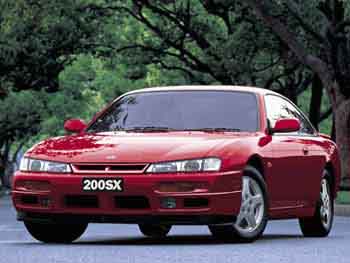
|
S15
|
|
Introduced January 16 1999. Some suspension parts came from the S14a Silvia and R34 Skyline,
some of which being aluminium, reduced the weight. Considerable effort was focussed
on tightening up the body.
Two models, Spec-S and Spec-R.
Power output of the updated SR20DET in Japan and NZ is around 186KW (250HP) for the manual and
164KW (220HP) for the Auto. Australian delivered cars remain at 147KW.
A 6-speed manual transmission is available on turbo
models. In Australia, manual versions get the Helical LSD (from the R34
GT-R) and Autos retain the Viscous LSD. Other markets Spec-S gets the
Viscous while Spec-R gets the Helical. Note that the 6MT gearbox is an
Warner unit, similar to the box in the Toyota Altezza and 350Z, not the
Gertrag box fitted to the GT-R
Australian cars do not get Climate A/C, boost gauge (Damn!) or the rear wiper.
Black added in place of Shiraz in the Australian line-up. Yellow was
introduced to the colour lineup in March 2001.
Here's the New Zealand-spec brochure For what it's worth, this is basically a translation of the Japanese brochure.
|
|

|
S16
|
Sadly, Nissan have announced that after more than 30 years, the Silvia was to
be discontinued in mid 2002 as the SR20DE and SR20DET do not meet incoming
Japanese emission standards (odd, because they are not as tough as ADR, which
Nissan Australia managed to meet, some writers have suggested this is really to
clarify the market for the 350Z, due in 2003). but
Nissan Australia kept the car on sale in Australia until some
time in late 2002, when all the available shells are used up. The GT-Spec
cars are a way of using the remaining Japanese-spec wings.
There may be an S16 developed for 2007, 2008. This was hinted at
during the Australian launch of the 350Z. We don't have any hard details
at the moment, but will be sure to post them as news develops.
January 2003:
The image at the right was posted recently in a Japanese magazine. We are in
the process of having it translated, so at this point, no guarrantee is made as
to whether or not this information is genuine. But it sounds encouraging.
June 2003:
A bit more information has come to light.
This is an artist's impression of what an S16 might look like. It is
based on an S15 image, and a Renault front end (Megane, I think). The
photos of the engine bay were from a Domestic Market X-Trail turbo.
July 2004:
Continuing delays on the next GT-R, and the success of the 350Z are starting to mark a shift in
Nissan's focus. Renault's control of Nissan appears to be
moving the company away from many of it's previous niche markets into a
more globally-oriented business. Sadly, this does not bode well
for a reintroduction of the Silvia.
August 2005:
Japan's "Motor Life" reports that Nissan are preparing an "entry-level sports coupe" for the world market under the
codename of "X6". A translation of the article says:
- The car will be a Front-Engine/Rear Drive configuration
- The powertrain is likely to be a variation of the Q series 4-cylinder engine (1.8 - 2.4 litre) and a 6-speed manual or semi-auto
transmission. Turbocharging is falling from favour in Japan, but is big in Europe, so whether is is turbo or NA is not clear. However, expect all the usual features from Nissan such as variable timing and probably variable lift as well.
- This is a new shell, but interior will probably be borrowed from other models in the family. (The Z Interior is growing on me, finally)
- The design would follow Nissan's trend towards "organic" styling (look at the Z, Maxima and Murano and you'll see what I mean)
- Expect a limited range of options to keep the manufacturing costs down.
- A convertible is not our of the question.
- The car will definitely be available in RHD and LHD configurations.
- Pressure would be on for X6 to wear the "Silvia" label in Japan and "SX" in the rest of the world.
October 2006:
If there is to be a new Silvia, the Fiorna concept car at the Sydney Motor Show could be a pointer to it. There is not a lot of hard data on it (Mainly because it's a "concept", but it is a 2+2 Front Engine/Rear Drive platform with half-sized "suicide doors" at the rear (ala RX-8 and 1940's Packards)
We've put together a small photo gallery and will update it as we go along. Click Here!
November 2007
At the Tokyo Motor Show, chief creative officer Shiro Nakamura announced Nissan would soon return to the small sports car market. He stated that the 2009 model year was a likely target. He said that while he is strongly in favour of the Front Engine/Rear drive platform, economic realities might result in a Front Wheel Drive car because neither Nissan, nor Renault have a suitable small F/R platform available.
Nissan are testing a small car which is similar in styling to the 350Z. The car has been spotted a number of times at the Nurburgring in Germany. (http://www.automobilemag.com/new_and_future_cars/2009/0706_2009_Nissan_BabyZ/index.html
It is said to be about 20% smaller than the existing Z, and being considerably narrower
it does not match the other recent sigtings of 2009 Z prototypes.
We are continuing to monitor developments.
|
|

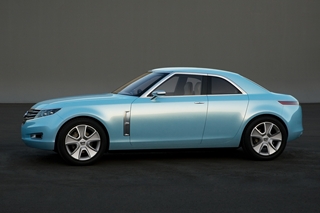
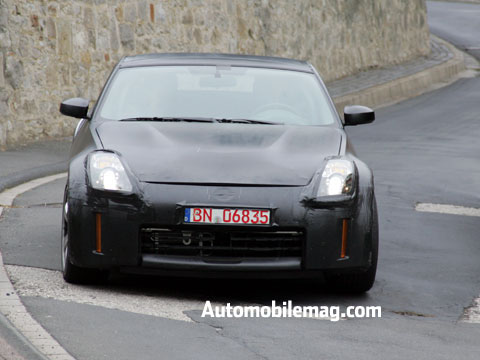
|
Top of Page Back to FAQ
|
Oddities:
|
Sil-Eighty
|
The "Sil-eighty" or "Sil80" which was largely an S13, but with the rear end styling from the PS13 180SX. This is what one correspondent had to say:
"...in Japan people kept smashing the front ends of their 180SXs when they were drifting... into mountains or
whatever. simply put, the S13 Silvia front end was cheaper than a 180SX front so
they put the Silvia fronts on as a temporary fix. this caused a craze in Japan
and it was basically the look in Japan for young people. Nissan had been
observing that many of their 180's have been going around with Silvia fronts,
and (for an unknown reason) they built a hybrid and released it in 1994. this
hybrid was known as the "SIL-EIGHTY", which is exterior-wise just a
PS13 with an S13 front end. changes went further though, with changes to
camshafts and the ECU, which gave roughly 16~18Kw more (not sure about how much
more torque) than both the Silvia and 180SX. also, the suspension was tweaked
for drifting purposes. Genuine Sil-eighty's are snap-tail happy, given too much
power thru a corner will result in a drift, maybe a spin if you try too hard...
Nissan only made about 400 genuine and documented examples, just about all were
snapped up upon their release. now at auctions they apparently go for as much as
immaculate R32 skyline GT-Rs"
|
|
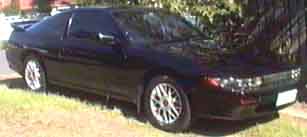
|
"One-Via"
|
|
Extending this idea to the next stage, why not take a 180SX nose, and put it
onto an S13 Silvia? Apparently it's not that hard to do (if you have
both). The result is sometimes called a "One-via". Note
that there is no factory-built car bearing this designation. Strictly,
since the North American S13's had popup lights on both coupe and hatch models,
it could be argued they are One-Via's. But it's not an argument I want to
have right now.
|
|
|
"Fifteen-Eighty"
|
|
And of course the newest oddity is the SIl1580 (180SX with an S15 nose).
This is not a factory product, but kits are available from a number of Japanese
styling houses. The name "Strawberry Face" comes from the sound of
"fifteen" and "strawberry" in Japan are very similar, and "face" is the front of
the car, so...
|
|
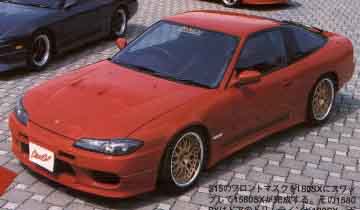
|
240RS
|
This is basically an S110 Silvia with an FJ24D engine installed. The
car was built by the factory for Group B rallying. The FJ20E engine
was modified to 2.4 litres with a new crank, pistons and manifolds which
converted the engine to use twin Weber sidedraft carburettors. I am not
sure exactly how many were built, but I have spotted two in Australia at motorsport events (both of UK Origins)
There were always stories about how the FJ20ET was derived from an aborted Formula One engine project.
While I am unable to find hard evidence to support these stories, the FJ24D being used in Group B
Rallying could be the origin of them...
|
|
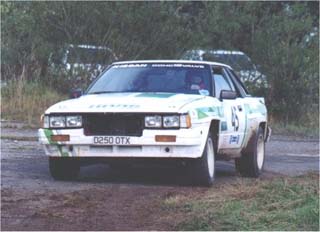
|
270R
|
Technically, this car was not produced by Nissan, but by it's motorsport arm,
NISMO. The car was released in limited numbers in 1994 using the S14
Silvia as it's base. New management, exhaust, intercooler, injectors
lifted output to 270HP (hence the name), while new suspension lowered the car
about 25mm and it was sold with 17" NISMO rims.
The body kit has become a popular choice for S14 owners and is commonly called an "edge" design.
Potential buyers should be aware these cars were produced in very limited
numbers, and the authenticity can be established by contacting Nissan Customer
Service in Japan. There was no (contrary to some advertising) S14a or S15
version of the 270R.
According to Nao T, here are the specs for the car, compared with the S14 Silvia K's
|
|
 
|
| Item |
Nismo 270R |
S14 Silvia K's |
Notes |
| Colour |
Black only. 270R Stripe |
Standard |
Unique scheme for the car |
| Serial Number |
Plaque inside glove compartment |
None |
Genuine cars are all numbered |
| Bonnet (Hood) |
Air exit vent |
None |
Unique to the 270R |
| Aero Kit |
Nismo "Edge" |
None |
|
| Steering Wheel |
Nismo 365 |
Standard |
|
| Wheels/Tyres |
F: 215/50/16
R:225/50/16
|
205/55/16 |
Nismo NS5R Forged Alloys |
| Power |
270PS @ 6000 |
220PS @ 6000 |
|
| Torque |
34.5kg/m @ 4800 |
28kg/m @ 4800 |
|
| Idle Speed |
1000RPM |
800RPM |
|
| Cam Data |
I: 62
E: 62
|
I: 60
E: 60
|
Unique to the 270R |
| Turbocharger |
Standard |
Standard |
|
| Intercooler |
Front Mount, similar to R32 GT-R |
Side Mount |
Unique to the 270R |
| Exhaust |
3" Design |
|
Unique to the 270R |
| ECU |
Nismo custom program in standard ECU |
|
Unique to the 270R |
| Injectors |
Nismo 444cc |
380cc |
|
| Fuel Pump |
195l/h |
180l/h |
Same spec as R32 GT-R |
| Clutch |
Nismo Heavy Duty |
Standard |
|
| Diff Ratio |
4.111 |
4.083 |
|
| LSD |
Nismo mechanical 2-Way |
VLSD |
|
| Drive Shafts |
Strengthened |
|
Unique to the 270R |
| Brakes |
F: 296 x 30mm
R: 297 x 18mm |
F: 280 x 30 mm
R: 258 x 9 mm
|
From R33 Skyline Type M |
| Brake Pads |
Custom |
Standard |
Unique to the 270R |
| Shock Absorbers |
F: 5-Step
R: 4-Step
|
|
Nismo Parts |
| Springs |
Nismo Type D |
|
|
| Engine Mounts |
Nismo Strengthened |
|
|
| Bushes |
Nismo High Strength |
|
|
| Strut Brace |
F: Nismo
R: Nismo
|
|
|
Autech Specials
Over the years, an external turning company,
Autech have produced
limited run Silvias (and other Nissan products) which are subsequently sold on
the domestic market through Nissan dealers.
Top of Page Back to FAQ
1.4 What are the differences in the cars?
OK, here's where it gets complicated. I'll try and deal with this by market:
Australia
All cars have SR20DET 2.0l DOHC Turbo Engine.
S15:
There are 2 trim levels
Spec-S: Airbag, ABS, Helical LSD (Manual, Viscous on Auto) are standard.
Spec-R: Add Sunroof, side skirts and rear-spoiler.
The Australian-spec cars lose the boost gauge through ADR,
the rear wiper was replaced by a high-mount stop light and different exhaust and
ECU program explain the differences between 147 and 185KW
In 2001, Nissan Australia produced the "GT" Spec Cars. Either a Spec-S or
Spec-R may be purchased in GT Trim, and gains the following items:
- Japanese Domestic Market rear spoiler
- Leather-trimmed seats and steering wheel
- Standard wheels in chrome trim
- Drilled alloy pedals
- Chrome trim for door handles and gearlever surround
- "GT" badging (from the Skyline family)
S14:
There are 3 trim levels
Limited This is the base car As of June 1997, Driver's Airbag, LSD and A/C are standard
Sport Add ABS, CD-Player, Leather steering wheel & gear knob (manual), rear spoiler
Luxury Add Passenger Airbag, Sunroof, Side skirts, Front spoiler, Front fog lights, Climate Control A/C (until 1999), 6-speaker audio
S13:
Never released in Australia
S12:
Sold as the Gazelle. in XE (luxury) and SGL (standard) trim in either the hatch or coupe shell
Used a twin-pug CA20E engine and either 5-speed manual or 3-speed auto
XE had "electronically adjustable" suspension
New Zealand
S15:
This is the Japanese-specification Spec-R with 186KW and 180Km/h speed limiter still in place.
S14:
This was the export-spec car, and should be identical to the Australian specifications.
S13:
Essentially a UK-spec RPS13
UK
S14:
SR20DET engine used in Japan (turbo models) and Australia. There are two trim levels
Base ABS, Drivers airbag, LSD, Alarm
Touring Add Leather interior, Air Conditioning, Passenger A/B, Add Side skirts and front spoiler.
S13:
Either CA18DET or SR20DET engines depending on time of delivery, using an RPS13 shell.
Europe
S14:
SR20DET engine used in Japan (turbo models) and Australia. Trim levels vary depending on the market.
S13:
Either CA18DET or SR20DET engines depending on time of delivery.
Japan
S15:
Choice of 2.0l normally aspirated (SR20DE) or turbo (SR20DET) engine.
Trim levels have been reduced from 3 in the S14 (J Q and K) to 2 (Spec S & Spec R).
Options included satellite navigation.
S14:
Three grades of car. The J's (basic) Q's (mid-spec) and K's (Turbo). Over the years the car was sold in Japan there were a very large number of
options, and trim combinations, so it's hard to track them all. Turbo
models had a small 3-gauge cluster under the single-DIN radio which housed
boost, oil pressure and voltage gauges. Other options included TV
receivers, Satellite navigation, one-way glass and so on.
A small number of S14a shells were sold on the domestic market after the
introduction of the S15. These were called a "200SX" There
was at least a "Type-X" but I have no hard data on them. (Players of GT2 will recognise this car)
S13:
The S13 has a bewildering range of models and configurations, so I will try to list the best known ones:
The S13 family (Chassis numbers beginning with S13, not PS13) had either a CA18DE or CA18DET engine, and had trim levels of J's Q's and K's. I believe
that the CA18DET (turbo) was only available in the K's spec, but I may be wrong
When the SR20DE and SR20DET engines were introduced, the chassis numbers changed to PS13, but the trim levels remained the same.
Parallel to all of this is PS13 and RPS13 180SX. It was possible to order them with a normally aspirated engine, but these tend to be rare.
USA
S13 and S14:
The car sold in the USA as a 200SX is derived from the Sentra (Pulsar), and is not the same as the rest of the world. The car I am
referring to is sold in the USA as a 240SX. It features a normally-aspirated 2.4l KA24DE engine. There are two trim levels
Base 15" Steel wheels
SE/LE 16" Alloy wheels, Fog lamps, Rear spoiler, chrome exhaust tips, A/C
In late 1998 the 240SX and 200SX were withdrawn from sale in the USA pending the release of the 350Z in 2002/3.
Top of Page Back to FAQ
1.5 Where did the boost gauge go on the Australian cars?
The S14 and S14a cars sold in export countries did not receive the 3-gauge
cluster fitted to the Silvia K's in Japan. Does this make them a Q's trim
with K's mechanicals? The reasons are most likely cost-related.
This is not definite, but my discussions with the engineering folks at Nissan
indicate that for the S15 to meet Australian Design Rules (ADR) define a "head impact area".
This means that the gauge, which was mounted on the A-Pillar was inside this
area and had to be removed. It was too expensive to relocate the gauge
elsewhere on the dash so it was deleted altogether.
While it is illegal to actually fit it, without getting an Engineer's Certificate (In New South Wales,
Australia anyway) you can order the gauge and it's pod through your Nissan
dealer. The part numbers are:
76911-85F10 Garnish Assy - Front (A-Pillar trim)
76970-85F10 Rear Bracket
76987-85F10 Escutcheon (second piece of the pod)
Top of Page Back to FAQ
1.6 What others say about the car
"2001 Performance Car of the Year" ,
Motor Magazine
"2001 Bang For Your Bucks", Motor Magazine
"The WRX they built with their heads, and the Type R with with their hearts. The 200SX gets the right amount of both"
Wheels Magazine, December 2000
"The best sports car under $55,000" NRMA, 1996, 1997
"A hugely involving car to drive, making the driver feel one with his machine," enthused Ellis.
"It's very together," added Hawley, while McConville reckoned "it was a very good all-round
package" and Newton said "he could happily own it".
While it's styling is understated, its performance is anything but. It is swiftness by stealth.
The lag-less turbocharged 2.0-litre engine creates 147 very useable kilowatts and works well
with the chassis to provide rapid, relentless and reliable performance. This was evidenced
by second-best grin points, quarter time, and equal-second top speed with the V8 Commodore
SS. It's enough to make die-hard Aussie muscle purists choke on their meat pies.
But while it was a healthy performer in the performance disciplines, in the accounting
equation it bombed, and that's why it couldn't better fifth place.
Its headlights, front guard and rear bumper are the most expensive out of this group of
six, and naturally enough insurance companies penalise owners of turbocharged two-door
sports cars. Add a hefty $1360 to replace a set of 16-inch Yokie A028 rubber and the neat
Nissan, while delivering good thrills, does so at a price in the long term. Finishing
fifth isn't a fail in this class; it merely serves to underline the competitive and
diverse nature of performance available to those with less than $45,000 to spend.
Modern Motor - "Bang for your buck 1997", July 1997
Top of Page Back to FAQ
1.7 What about owner's clubs?
The Nissan Sports Car Club has been established. Contact
info@nissansportscarclub.org for more details. You can read the official
launch announcement here.
There is an internet-based club in the US. It's web-site is http://www.240sx.org These
folks also maintain a mailing list which is full of useful information.
There is a group of owners who get together in Sydney from time to time
(usually breakfast and check out each other's cars), Let
me know if you're interested.
An Australian S13 Owner's list has started. Details can be found at http://www.egroups.com/list/nissans13/
A Swedish owners site is up and running. You can find it at http://www.200sx.nu/
Please let me know if you'd like your club included in this list.
Top of Page Back to FAQ
1.8 What about the convertible?
S13
|
|
There was a limited edition S13 convertible, a few hundred cars were built by the factory to use up the
last of the S13 coupe shells. All of the original cars were painted "Royal Blue", and had the fixed headlights
of the Silvia, rather than the 180SX/240SX (PS13) pop-ups. There have been
several conversions. The Autech
package being the most common in Japan at least
|
|
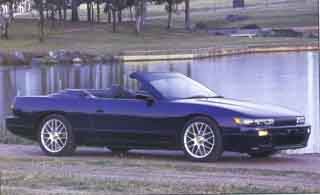
|
|
In the US, there was an S13 240SX convertible. According to information I received, these were based on the coupe
and actually converted at Nissan's North American facility. It is
distinguishable by the pop-up lights, being left-hand drive and having a 240SX
badge.
|
|
|
S14
|
|
There was no "factory" S14 convertible (or hatch for that matter). I am told there have been some private conversions done but the only one I have
ever seen was for the movie "Into the Red"
|
|
|
S15
|
|
When the S15 was released, there was only a coupe, but recently Nissan has
introduced the "Silvia Convertible" or "Varietta", which was
developed by Autech. Mechanically, the car uses the SR20DE engine with a
choice of 5-speed manual or 4-speed auto transmission. The car was never
officially exported.
|
|
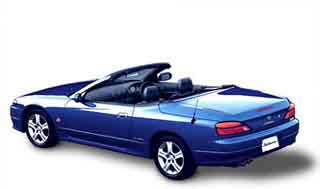
|
Top of Page Back to FAQ
1.9 Why is it a 240SX in North America?
This is a pretty vexing question, especially if you happen to
live there. When the S13 was introduced to the North American Market,
Nissan North America chose not to import cars with the turbocharged engines
(CA18DET or SR20DET).
Still needing good performance they selected the KA24E 2.4 litre
engine used in the Bluebird (Altima) and a couple of commercial vehicles.
At 130HP it was not slow, and when updated to the 155HP KA24DE engine
performance improved even further.
Having driven a 240SX, they are quite well balanced, and the large (compared to the 2.0 litre cars) amount
of torque at low revs means they are quite a lot of fun when stirred along.
But the question remains, why? Several reasons have
surfaced, and the truth is that it is probably a combination of these and other
factors which led to the birth of the 240SX:
- The KA24E engine costs less that the CA18DET and produced similar power. This is not quite as compelling when looking at the SR20DET.
- A 200SX with similar performance to a normally aspirated 300ZX but at a much lower price would have cannibalised sales of both 300ZX variations. The Twin-Turbo was sold only in Japan and North America, so elsewhere this was not a concern.
- At the time of introduction, "Premium" (RON higher than 93) was rare in North America. California and Florida were key markets, and with the high temperatures, detonation would be a real problem, not to mention poor performance.
- In the later years, common parts with the Altima (Bluebird) kept spares pricing down for this low-volume car.
Top of Page Back to FAQ
1.10 What about the 4WD version?
There have been rumours of this for some time, but I have no evidence that
the car ever did, or does now exist. Perhaps there have been private
conversions done using components from the 4WD Skylines (GTS4, etc) but most of
these are autos.
An update to this. Yoshi, a correspondent in Kobe Japan is
presently building his own 4WD S14 Silvia. Most of the mechanical
components have been sourced from an R32 Skyline GTS4. He tells me he has
fitted the gearbox and transfer assembly using a custom fabricated bellhousing.
Assuming my translation is accurate, he says the big difficulty is clearing the
parts of the front subframe with the drive shafts. Photos will
hopefully come soon!
If anyone's got anything on it, please let me know
Top of Page Back to FAQ
1.11 Why isn't there much information on the North American S12 200SX?
Some folks think I don't like these cars, that's not true. Simply we have not been able to find much information about them. Any
information we receive will be added to the relevant pages, so please share the
knowledge if you have it.
Top of Page Back to FAQ






Copyright, © 1997, 1998, 1999, 2000, 2001, 2002, 2003, 2004,
2005, 2006, 2007,2008 Christopher F. Moran.
No part of this work may be reproduced without prior authorisation.
The following are (or are likely to be) trademarks of the Nissan Motor Company
and/or it's subsidiaries:
"Nissan", "Silvia", "200SX", "240SX", "180SX", "240RS", "270R", "Sil80",
"Nismo", "Datsun", "Gazelle", "Pulsar", "Sentra", "Skyline", "JECS", "ECCS","
HICAS"
The following are trademarks associated with Christopher F. Moran:
Emergent Technology", "www.emergent.com.au", "www.200sx.org", "200sx.org",
"Don't just look at it. Drive it..."
Other names mentioned may or may not be trademarks of their respective owners.
While every possible care is taken to verify the material published on these
pages, the authors accept no responsibility for any content or any effects
arising from using the content. You should check with local authorities
regarding the legality of any modifications listed here.
Always drive your car sensibly and according to the relevant laws in force
where you are.





















